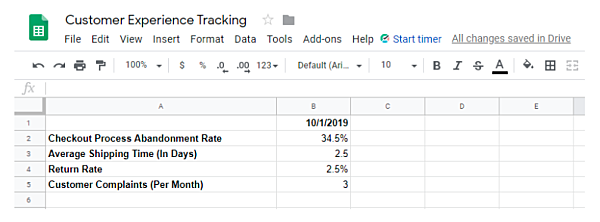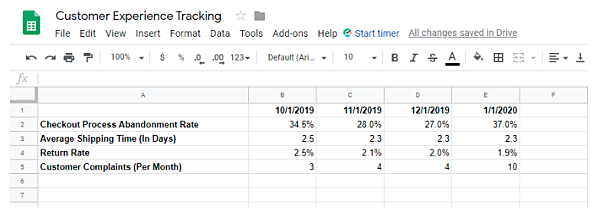2020 might just be the “year of customer experience.”
According to the annual Digital Trends report by Econsultancy and Adobe, B2B companies view customer experience (CX) as the most exciting opportunity for 2020—beating out content marketing, video marketing, and social media marketing.
That’s huge, but it shouldn’t come as a surprise, given that 2018 research by Gartner found that, “Nearly half of organizations in a Gartner survey claimed they can track the financial benefits of CX projects, while Gartner's marketing leaders survey shows that over 80% of organizations expect to compete mainly based on CX.”
But it’s one thing for enterprise-level companies and marketing leaders to go all-in on customer experience. How can small businesses—who may already be juggling multiple priorities on limited budgets—compete?
Although CX may look slightly different for small business owners, it’s still an important priority for 2020. Here’s why it matters and how to do it well:
What is customer experience?
First of all, “customer experience” does not equal “customer service” (or even “customer success,” a term that’s widely used in the SaaS world). According to industry expert Jason Bordeaux, customer experience is, “the impression you leave with your customer, resulting in how they think of your brand, across every stage of the customer journey.”
With that in mind, possible customer experience activities might include, among others:
- Adding new support channels (such as live chat) to make it easier for customers to get the answers they need
- Increasing the amount of helpful information on your website by building out blog content, FAQs, or knowledge base articles
- Minimizing friction in the checkout process by eliminating unnecessary steps or condensing form fields
- Building policies around how quickly you’ll follow up with questions and/or issues (such as committing to responding to all requests within 48 business hours)
- Practicing positive communication and active listening when interacting with customers (for example, by making instant video conferencing available for solving tricky customer support issues)
- Establishing a returns process that customers feel good about
Customer experience isn’t about bending over backward to prioritize your customers’ needs over your company's well-being. You don’t have to give in on every issue just to keep customers happy. Instead, it comes down to helping customers feel good about choosing to work with your company over your competitors.
Why prioritize customer experience in 2020?
Still not convinced? Consider that, beyond the data points listed above, PWC’s Future of CX report found that:
- Customers are willing to pay up to a 16% price premium on products and services, plus increased loyalty when they have a positive experience
- One in three consumers (32%) say they will walk away from a brand they love after just one bad experience
- 82% of U.S. and 74% of non-U.S. consumers want more human interaction in the future
Simply put, if you invest in building a great customer experience, your small business stands to earn more sales, retain more customers, and create stronger relationships that’ll carry your company forward in today’s increasingly competitive business landscape.
No more leads will fall through the cracks. Keap software promptly responds to incoming leads and existing contacts by sending highly personalized communications that drive action or sales. Demo here: https://t.co/nsWYIuaOic pic.twitter.com/7ctXOFzOhs
— Keap (@KeapGrowing) January 28, 2020
Your customer experience game plan for 2020
Ready to get started? Even if you think you’re already doing CX well, taking a closer look at your program may be worthwhile. According to the PWC report referenced earlier, “54% of U.S. consumers say customer experience at most companies needs improvement.”
To make sure your CX is top-notch, PWC shares that, “Speed, convenience, helpful employees and friendly service matter most, each hitting over 70% in importance to consumers.”
Here’s how to put these priorities into practice at your small business in 2020:
Step 1: Identify opportunities to improve these four areas at your business
Customer experience is such a wide-ranging discipline that it can be difficult to tell where to start, especially for small businesses that have limited time, resources, or bandwidth to implement change. Do you tackle checkout problems first? Invest in building out new customer service channels?
The correct answer will vary from company to company, but you can take your cues from the four areas highlighted by PWC:
- Speed
- Convenience
- Helpful employees
- Friendly service
Speed
Speed can manifest in a number of ways. The time needed to complete a checkout process is a speed consideration, as is the time between when an order is placed and when it arrives at your customer’s location. In the context of professional services, speed concerns might include how quickly emails are replied to or when deliverables are sent.
The good thing is that you’ll know if you have speed problems. Customers will let you know you’re lagging in the form of complaints or follow-up messages. You can tell you’ve got a speed problem if your inbox is full of emails reading, “Can I get an ETA on this?”
Convenience
Issues affecting convenience can be more difficult to identify than speed challenges. If your website is difficult to navigate, for example, customers may not reach out for help finding the products or information they were seeking. They may just leave, in search of competitor websites that are easier to navigate.
One of the better tools in your arsenal for identifying convenience issues is your website’s analytics program. If you’re seeing abnormally high bounce rates or high exit rates, these could be signals that visitors are leaving without finding the information they were seeking. Pair these insights with those from a heatmap tool, which will help you identify needless clicks on unclickable areas that could frustrate visitors.
Tools like exit intent pop-ups and live chat sessions can be helpful in resolving website-based convenience challenges by interjecting helpful information. More broadly, customer satisfaction surveys can be used to capture insights into possible areas of improvement after a purchase or engagement has concluded.
Helpful employees
If your business is so small that you don’t have employees, save your time and focus on the other three areas listed here (as long as you, yourself, are providing customers with a great experience). And if you do have team members operating on your company’s behalf, make sure they’re as committed to customer experience as you are.
If you’re receiving complaints about an employee’s conduct, that’s a giveaway that you’ve got work to do. But more subtle signals can indicate problems as well. As an example, monitor the number of messages required to resolve a customer’s issue. If it seems high, there’s a chance employees are offering cursory service, rather than proactively anticipating the customer’s needs in a way that’s truly helpful.
Friendly service
If you’ve invested in making sure your employees are helpful, the issue of providing friendly service may take care of itself. However, it can still be valuable to focus dedicated effort here, as helpful doesn’t always translate directly to a perception of friendliness.
Take the time to think through the friendliest customer service interactions you’ve experienced. What was it that made those encounters so positive? Are you offering something similar to your customers?
The great news is that offering friendly service is one of the more cost-effective ways to improve your small company's customer experience. Greeting every person who enters your location or sending a handwritten thank you note to new clients costs almost nothing, but can have a major impact on customer satisfaction.
Step 2: Establish metrics that quantify your performance in these areas
If the four factors above don’t resonate with your specific type of business, feel free to choose something else to focus on. But regardless of where you turn your attention, translate the specific opportunities you want to focus on into metrics you can track.
A few common CX metrics include:
- Return rates - Higher than average return rates suggest that your customer experience isn’t giving customers the information they need to make an educated decision (or that it’s misleading customers, unintentionally or otherwise).
- Average customer lifetime value - As your experience improves, customer loyalty and referrals should as well. CX investment should result in an upward-trending CLV.
- NPS - Net promoter score measures how likely your customers are to refer you to others. Average scores below 7 suggest CX problems.
- CSAT scores - Conduct customer satisfaction surveys on a periodic basis to ensure positive performance (or to catch emerging issues in order to resolve them quickly).
Try to identify three to five key metrics that seem as if they’d have the biggest impact on your company's customer experience. If you’re an ecommerce shop, for example, you might want to track checkout process abandonments, average shipping times, return rates, and customer complaints.
If, on the other hand, you’re a B2B service provider, it may make more sense to focus on the average time needed to respond to inquiries, the percentage of deliverables given to clients on time, NPS ratings, and the number of successful referrals received from happy customers.
Step 3: Take baseline measurements
Once you know which specific metrics you want to focus on, establish a baseline measurement for each. Without these critical starting points, you won’t be able to tell whether changes you implement are making an impact—or whether new issues are arising that you need to address quickly.
Put these initial numbers into a spreadsheet and plan to update them at least once per quarter to ensure your customer experience is improving.

Step 4: Implement changes, based on the resources you have available
As tempting as it might be to make dozens of customer experience changes at once, adopting a more scientific approach will produce better results in the long run.
Based on your target metrics and the baseline data you observed, try to guess which improvements will have the greatest impact on your business.
Looking at the sample data above, if you received three customer complaints in the past month and all of them had to do with technical errors in the checkout process, you could conclude that making improvements to your checkout flow is likely to produce the biggest CX wins.
By making changes to a smaller number of variables at once, you’ll be able to determine whether or not your actions are having an effect—all while making smarter use of the smaller number of resources available to you as a small business.
Help grow the community by referring friends and family that could benefit from the product and get rewarded with $100. https://t.co/k3S9ptO0VQ pic.twitter.com/0XzwHIvz4E
— Keap (@KeapGrowing) January 24, 2020
Step 5: Monitor your progress and iterate as needed
As you make changes, continue to measure your progress and look for trends in the spreadsheet you created earlier.

In this example, it’s clear something happened around the January 1st measurement data that produced a higher number of checkout abandonments and customer complaints. If you’d recently made changes to your checkout flow, this could indicate that they aren’t working as expected. And if you haven’t, they’re a clear signal that a new problem is taking shape on your site.
Investing in customer experience in 2020
CX is expected to be a critical competitive differentiator in 2020, but it doesn’t have to be the kind of nebulous, poorly defined pursuit many companies anticipate when they hear the words, “customer experience.”
By understanding the importance of customer experience in 2020 and launching a data-driven process to improve it, even the smallest of businesses can benefit from greater customer goodwill without having to invest an untenable level of resources.
About the author
Jamie Davidson is the Marketing Communications Manager at Vast Conference, a leading provider of HD audio and video conferencing services.


